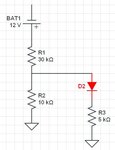Krebstar4000
Newbie level 3
I recently started reading Malvino Electronic Principles to further my understandings for hobby electronics. I've been stuck for a few hours on a problem out of chapter 3 of the 6th edition 3-29. "What value should R2 be to set up the diode current of 0.25 mA"

I'm not sure why I've been so stuck on this problem it seems easy enough on the surface. I know the answer is 23 k ohms but I can't get there.
The method that makes sense to me which doesn't give the correct answer is to calculate Vout needed by doing IR=V and that is .25mAx5kohm which gave me 1.25v for my Vout. from there I did R2 = R1/((Vin/Vout)-1) and that gives me 3.4k ohms which isn't the right answer.
I've gone around in circles but obviously I'm missing or misunderstanding a concept here and would like to be pointed in the right direction.
Thanks

I'm not sure why I've been so stuck on this problem it seems easy enough on the surface. I know the answer is 23 k ohms but I can't get there.
The method that makes sense to me which doesn't give the correct answer is to calculate Vout needed by doing IR=V and that is .25mAx5kohm which gave me 1.25v for my Vout. from there I did R2 = R1/((Vin/Vout)-1) and that gives me 3.4k ohms which isn't the right answer.
I've gone around in circles but obviously I'm missing or misunderstanding a concept here and would like to be pointed in the right direction.
Thanks